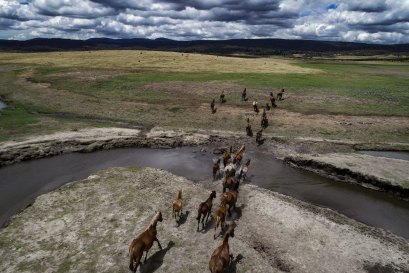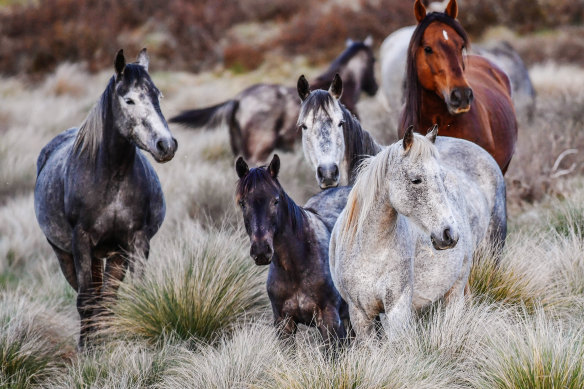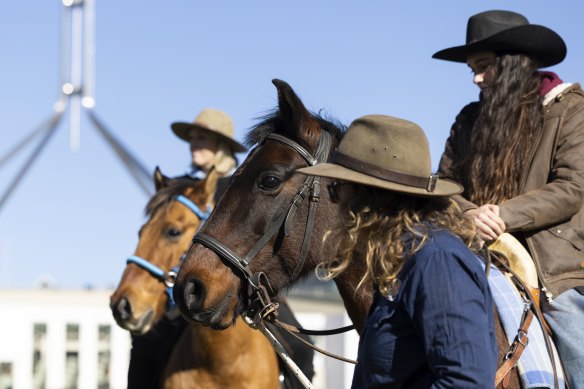- Exclusive
- Environment
- Conservation
- Brumby cull
This was published 8 months ago
Total removal of feral horses planned for some national parks
By Bianca Hall and Caitlin Fitzsimmons
Authorities in Victoria and NSW are aiming for total eradication of feral horses in several national parks, simultaneously undertaking the states’ biggest feral animal control programs to date.
In Victoria, a concerted campaign to eradicate feral horses from the Barmah National Park near the NSW border has been largely successful, with more than 700 horses removed from the park over four years – mostly by ground shooting – and another 96 found dead following floods in 2022.

NSW has approved aerial shooting to tackle feral horse numbers in the Kosciuszko National Park.Credit: Wolter Peeters
There are believed to be fewer than 100 left in Barmah, and there have been no sightings for more than a month. More than 1400 feral horses have been shot in Victoria’s Alpine National Park over four years.
In NSW, the government is seeking to eradicate feral horses in the World Heritage-listed Greater Blue Mountains and Barrington Tops, and is undertaking its annual survey to estimate the population in Kosciuszko National Park, where it is legally obliged to retain a population of 3000 brumbies for heritage value.
In both states, the backlash to horse eradication programs by supporters of brumbies – which provide a living link to colonial history – has been fierce. A NSW upper house inquiry reported on Wednesday that national park staff working on horse control “have often faced terrible abuse online and in the community”.
Invasive Species Council acting chief executive Jack Gough said feral horses and other hard-hoofed feral animals “cause enormous damage in terms of trashing, trampling, polluting, suppressing regeneration of landscapes”, and it was pleasing to see NSW and Victoria take the problem seriously. Wild horse populations grow at about 18 to 20 per cent a year.

Brumbies off the Snowy Mountain highway in Kosciuszko National ParkCredit: Joe Armao
Gough said feral horses also caused damage in the wet tropics, including Cape York, the Gulf of Carpentaria and Kakadu National Park, and called on the federal government to fund effective feral animal control nationally.
“In Queensland and the Northern Territory, the main restriction on action on feral horses is resources, whereas the issue in NSW and Victoria has been political will,” Gough said.
Victoria has a long-term strategy to reduce the number of horses in Barmah to zero, but in remote parts of the Victorian Alps, feral horses are so well established that Parks Victoria says it is unlikely they will ever be fully eradicated.
In the Blue Mountains and other parts of the Warragamba catchment, west of Sydney, a NSW National Parks and Wildlife Service spokesperson said, this year’s spring control program included aerial shooting of 93 of an estimated 100 horses, as well as 463 pigs, 72 goats, 48 deer and one fox.
The NSW government is also seeking to eradicate feral horses in the World Heritage-listed Barrington Tops, the mountainous area between the Hunter Valley and the Mid North Coast, as part of what it says is the state’s biggest yet feral animal control program.
NSW Environment Minister Penny Sharpe said invasive species, including horses, cost the state’s economy more than $1.9 billion a year.
“Wild horses in Barrington Tops and Warragamba catchment were ignored for more than 20 years, but our government will continue to remove them in accordance with the highest animal welfare standards,” Sharpe said.
Since January, NPWS has killed 662 invasive animals in Barrington Tops, including horses, pigs, rabbits and hares. A spokesperson said the pests were damaging fragile sub-alpine areas and degrading habitats for endangered species such as the broad-toothed rat and rare orchids, as well as endangering the public by wandering into campgrounds and popular walking areas.

A rally calling for brumbies to be rehomed as a priority method of management outside Parliament House.Credit: Alex Ellinghausen
NPWS said about 160 feral horses remained in Barrington Tops. If there is sufficient interest, then the service will trap horses for rehoming in 2025 before reducing the population to zero.
In Kosciuszko, the government is bound by legislation passed by the former government to preserve a brumby population. NPWS is required to reduce horse numbers to 3000 – but no lower – by 2027 in retention areas, and can aim for zero elsewhere in the park.
The November 2023 survey, using trained observers on helicopters, estimated more than 17,000 feral horses in Kosciuszko, an increase from about 6000 in 2014. In the past year, NPWS removed 6393 horses from the park, more than 90 per cent by aerial shooting.
The upper house inquiry, which had dissenting sections from the Animal Justice Party and the Nationals, found aerial shooting should continue alongside rehoming, and NPWS should investigate fertility control.
A Parks Victoria spokesman said the agency had launched a strategic action plan in 2020 for Barmah National Park after feral animals including horses and deer caused widespread ecological damage. The plan, developed with widespread consultation, aims to eradicate feral horses from the park and had been “largely successful”, he said.
The spokesman said horses in particular caused “large-scale and long-lasting” damage by trampling vegetation, distributing weeds and damaging fragile soils, and the destruction caused by feral animals was exacerbated by accelerated impacts of climate change.